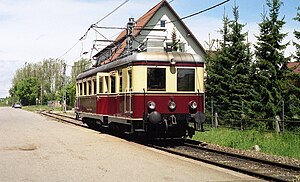TE T3
| TE T3 | |
|---|---|
| Numbering: | T3 |
| Number: | 1 |
| Manufacturer: | mechanical: Maschinenfabrik Esslingen electrical: AEG |
| Year of construction (s): | 1938 |
| Axis formula : | Bo'Bo ' |
| Gauge : | 1435 mm ( standard gauge ) |
| Length over buffers: | 15,050 mm |
| Trunnion Distance: | 8,600 mm |
| Bogie axle base: | 2,500 mm |
| Total wheelbase: | 11,100 mm |
| Service mass: | 34,610 kg |
| Continuous output : | 4 × 75 kW |
| Power system : | 600 V = |
| Power transmission: | Overhead line |
| Number of traction motors: | 4th |
| Brake: | el. resistance brake magnetic rail brake compressed air brake hand brake |
| Seats: | 60 |
| Classes : | 2nd / 3rd |
The TE T3 is a four - axle standard gauge electric multiple unit of the Trossinger Eisenbahn (TE) for their route from Trossingen train station to Trossingen city .
The railcar was procured in 1938 to supplement the existing vehicle fleet with the TE T1 and 2 railcars and the TE EL4 electric locomotive . The T3 was also used for freight transport. In 1990 there was a historical review. It is located as a museum vehicle at the Freundeskreis der Trossinger Eisenbahn e. V. and is used for special trips.
history
The first vehicles on the Trossingen Railway were built in 1898. After around 40 years, these were no longer sufficient for freight traffic. With the new vehicle, 120 t could be transported uphill and 200 t downhill.
The railcar was mainly used for this purpose until the cessation of freight traffic in 1996. Since the T6 was prone to failure, the car was reactivated in 2002 and was in use until 2003 when the Hohenzollerische Landesbahn AG (HzL) took over passenger transport . It is used with the T1 , the EL4 and the T5 in museum traffic.
construction
Upon delivery, the car had a 2nd class compartment for eight people and a 3rd class compartment for 52 people. There was also a mail and luggage compartment. The entry room with retracted doors was off-center between the two compartments. The driver's cab was separated from the passenger compartments. Due to the short deployment distance, there was no toilet.
The car body is a welded construction and is made in frame construction. The vehicle was delivered without seats, these had to be installed after arriving in Trossingen. The mechanical part was manufactured by the Esslingen machine factory . The electrical equipment, which consists of the vehicle control system and the four drive motors designed in a pawl bearing design , comes from AEG . Originally the railcar was painted red / beige with a black frame and silver roof. At times it was painted blue and white. As a museum vehicle, it is painted in the original version. The top lighting consists of four lights. The middle light above the dome hook served as adjustable camouflage lighting against air attacks. Functional blackout lighting is available in the passenger compartment .
literature
- Gerd Wolff, Hans-Dieter Menges: German small and private railways. Volume 3: Württemberg . Eisenbahn-Kurier, Freiburg 1995, ISBN 3-88255-655-2 .
- Trossingen Railway . In: railway magazine . No. 10 , 1989, ISSN 0342-1902 , pp. 30-34 .
Web links
- Website about the Friends of the Trossinger Eisenbahn e. V. with mention of the T3
- Photos from the Trossingen railway with mention of the TE T3 on Bahnbilder.de
